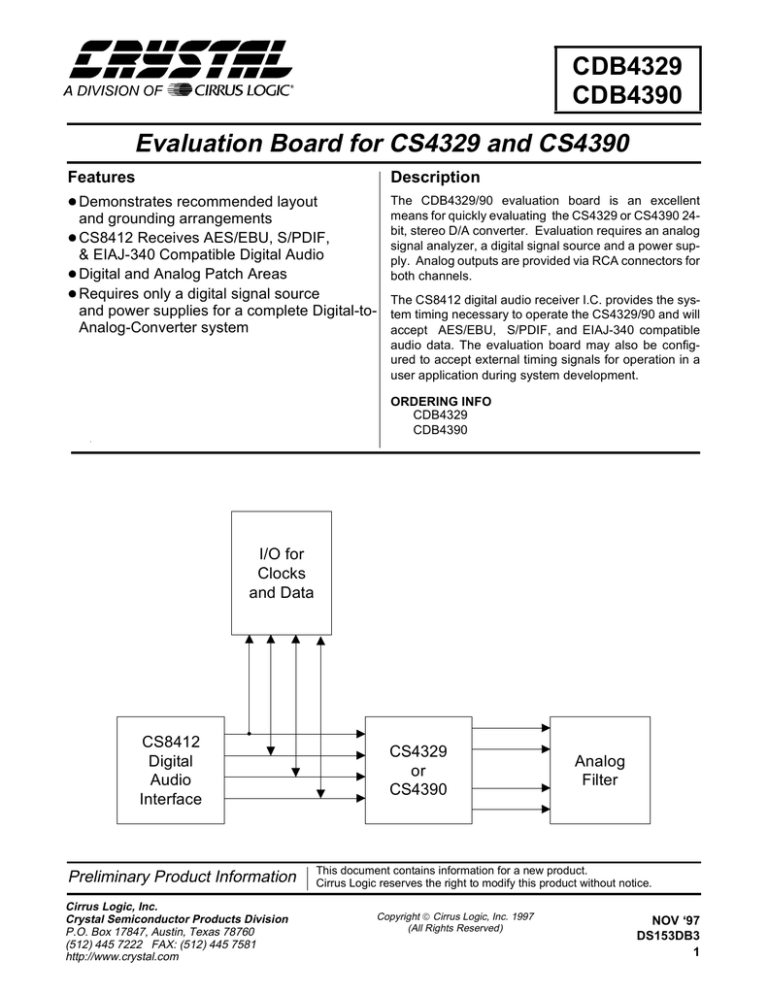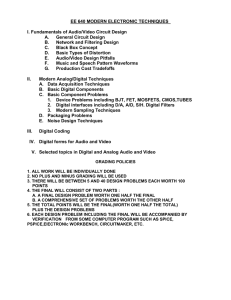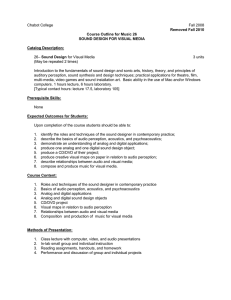
CDB4329
CDB4390
Evaluation Board for CS4329 and CS4390
Features
Description
l Demonstrates recommended layout
The CDB4329/90 evaluation board is an excellent
means for quickly evaluating the CS4329 or CS4390 24bit, stereo D/A converter. Evaluation requires an analog
signal analyzer, a digital signal source and a power supply. Analog outputs are provided via RCA connectors for
both channels.
and grounding arrangements
l CS8412 Receives AES/EBU, S/PDIF,
& EIAJ-340 Compatible Digital Audio
l Digital and Analog Patch Areas
l Requires only a digital signal source
The CS8412 digital audio receiver I.C. provides the sysand power supplies for a complete Digital-to- tem timing necessary to operate the CS4329/90 and will
Analog-Converter system
accept AES/EBU, S/PDIF, and EIAJ-340 compatible
audio data. The evaluation board may also be configured to accept external timing signals for operation in a
user application during system development.
ORDERING INFO
CDB4329
CDB4390
I
I/O for
Clocks
and Data
CS8412
Digital
Audio
Interface
Preliminary Product Information
Cirrus Logic, Inc.
Crystal Semiconductor Products Division
P.O. Box 17847, Austin, Texas 78760
(512) 445 7222 FAX: (512) 445 7581
http://www.crystal.com
CS4329
or
CS4390
Analog
Filter
This document contains information for a new product.
Cirrus Logic reserves the right to modify this product without notice.
Copyright Cirrus Logic, Inc. 1997
(All Rights Reserved)
NOV ‘97
DS153DB3
1
CDB4329 CDB4390
CDB4329/90 SYSTEM OVERVIEW
The CDB4329/90 evaluation board is an excellent
means of quickly evaluating the CS4329/90. The
CS8412 digital audio interface receiver provides an
easy interface to digital audio signal sources including the majority of digital audio test equipment. The evaluation board also allows the user to
supply clocks and data through a 10-pin header for
system development.
The CDB4329/90 schematic has been partitioned
into 8 schematics shown in Figures 2 through 9.
Each partitioned schematic is represented in the
system diagram shown in Figure 1. Notice that the
system diagram also includes the interconnections
between the partitioned schematics.
CS4329/90 Digital to Analog Converter
A description of the CS4329 or CS4390 is included
in the CS4329 and CS4390 data sheets.
CS8412 Digital Audio Receiver
The system receives and decodes the standard
S/PDIF data format using a CS8412 Digital Audio
Receiver, Figure 9. The outputs of the CS8412 include a serial bit clock, serial data, left-right clock
(FSYNC), de-emphasis control and a 256Fs master
clock.
During normal operation, the CS8412 operates in
the Channel Status mode where the LED’s display
channel status information for the channel selected
by the CSLR/FCK jumper. This allows the CS8412
to decode and supply the de-emphasis bit from the
digital audio interface for control of the CS4329/90
de-emphasis filter via pin 3, CC/F0, of the CS8412.
When the Error Information Switch is activated,
the CS8412 operates in the Error and Frequency information mode. The information displayed by the
LED’s can be decoded by consulting the CS8412
data sheet. If the Error Information Switch is activated, the CC/F0 output has no relation to the deemphasis bit and it is likely that the de-emphasis
2
control for the CS4329/90 will be erroneous and
produce an incorrect audio output.
Encoded sample frequency information can be displayed provided a proper clock is being applied to
the FCK pin of the CS8412. When an LED is lit,
this indicates a "1" on the corresponding pin located on the CS8412. When an LED is off, this indicates a "0" on the corresponding pin. Neither the L
or R option of CSLR/FCK should be selected if the
FCK pin is being driven by a clock signal.
The evaluation board has been designed such that
the input can be either optical or coax, Figure 8. It
is not necessary to select the active input. However,
both inputs can not be driven simultaneously.
Data Format
The CS4329/90 must be configured to be compatible with the incoming data and can be set with
DIF0, DIF1, and DIF2. The CS8412 data format
can be set with the M0, M1, M2 and M3. There are
several data formats which the CS8412 can produce that are compatible with CS4329/90. Refer to
Table 2 for one possibility.
Power Supply Circuitry
Power is supplied to the evaluation board by four
binding posts, Figure 10. The +5 Volt input supplies power to the CS4329/90 (through VA+), the
CS8412 (through VA+ and VD+), and the +5 Volt
digital circuitry (through VD+). The ±12 volt input
supplies power to the analog filter circuitry.
Input/Output for Clocks and Data
The evaluation board has been designed to allow
the interface to external systems via the 10-pin
header, J1. This header allows the evaluation board
to accept externally generated clocks and data. The
schematic for the clock/data I/O is shown in Figure
7. The 74HC243 transceiver functions as an I/O
buffer where the CLK SOURCE jumper determines if the transceiver operates as a transmitter or
receiver.
DS153DB3
CDB4329 CDB4390
The transceiver operates as a transmitter with the
CLK SOURCE jumper in the 8412 position.
LRCK, SDATA, and SCLK from the CS8412 will
be available on J1. J22 must be in the 0 position and
J23 must be in the 1 position for MCLK to be an
output and to avoid bus contention on MCLK.
The transceiver operates as a receiver with the CLK
SOURCE jumper in the EXTERNAL position.
LRCK, SDATA and SCLK on J1 become inputs.
The CS8412 must be removed from the evaluation
board for operation in this mode.
There are 2 options for the source of MCLK in the
EXT CLK source mode. MCLK can be an input
with J23 in the 1 position and J22 in the 0 position.
However, the recommended mode of operation is
to generate MCLK on the evaluation board. MCLK
becomes an output with LRCK, SCLK and SDATA inputs. This technique insures that the
CS4329/90 receives a jitter free clock to maximize
performance. This can be accomplished by installing a crystal oscillator into U4, see Figure 9 (the
socket for U4 is located within the footprint for the
CS8412) and placing J22 in the 1 position and J23
in the 0 position.
Analog Filter
The design of the second-order Butterworth lowpass filter, Figure 6, is discussed in the CS4329 and
CS4390 data sheets and the applications note "Design Notes for a 2-pole Filter with Differential Input."
DS153DB3
Grounding and Power Supply Decoupling
The CS4329/90 requires careful attention to power
supply and grounding arrangements to optimize
performance. The recommended power arrangements would be VA+ connected to a clean +5 Volt
supply. The voltage VD+ (pin 6 of the CS4329/90)
should be derived from VA+ through a 2 ohm resistor and should not used for any additional digital
circuitry. Ideally, mode pins which require this
voltage should be connected directly to VD+ (pin 6
of the CS4329/90) and mode pins which require
DGND should be connected directly to pin 5 of the
CS4329/90. AGND and DGND, Pins 4 and 5, are
connected together at the CS4329/90. However, it
was not possible to connect VD+ (pin 6 of the
CS4329/90) and DGND to the mode pins on the
CDB4329/90 due to layout complications resulting
from the hardware selected to exercise the features
of the CS4329/90.
Figure 2 shows the CS4329/90 and connections.
The evaluation board has separate analog and digital regions with individual ground planes. DGND
for the CS4329/90 should not be confused with the
ground for the digital section of the system (GND).
The CS4329/90 is positioned over the analog
ground plane near the digital/analog ground plane
split. These ground planes are connected elsewhere
on the board. This layout technique is used to minimize digital noise and to insure proper power supply matching/sequencing. The decoupling
capacitors are located as close to the CS4329/90 as
possible. Extensive use of ground plane fill on both
the analog and digital sections of the evaluation
board yield large reductions in radiated noise effects.
3
CDB4329 CDB4390
CONNECTOR
+5V
±12V
GND
Digital input
Optical input
J1
AOUTL
AOUTR
INPUT/OUTPUT
input
input
input
input
input
input/output
output
output
SIGNAL PRESENT
+5 Volts for the CS4329/90, CS8412 and digital section
±12 volts for analog filter section
ground connection from power supply
digital audio interface input via coax
digital audio interface input via optical
I/O for system clocks and digital audio data
left channel analog output
right channel analog output
Table 1. System Connections
JUMPER
CSLR/FCK
Clock Select
J22
J23
M0
M1
M2
M3
auto_mute
DEM0
DEM1
DIF0
DIF1
DIF2
SCLK
DEM_8412
PURPOSE
Selects channel for
CS8412 channel status
information
Selects source of system
clocks and data
Selects MCLK as
input or output
CS8412 mode select
CS4329/90 Auto Mute
De-emphasis select
CS4329/90 digital input
format
CS4329/90 SCLK Mode
Selects source of deemphasis control
POSITION
L
R
FUNCTION SELECTED
See CS8412 data sheet for details
*8412
EXT
0
1
*Low
*Low
*Low
*Low
*Low
High
*High
*Low
*High
*High
*Low
*INT
EXT
*Low
High
CS8412 clock/data source
External clock/data source
See Input/Output for Clocks and Data section of
text
See CS8412 data sheet for details
On
Off
See CS4329 and CS4390 data sheets for details
set for 44.1 kHz
See CS4329 and CS4390 data sheets for details
Internal SCLK Mode
External SCLK Mode
CS8412 de-emphasis
De-emphasis input static high
Notes: 1. * Default setting from factory
Table 2. CDB4329/90 Jumper Selectable Options
4
DS153DB3
CDB4329 CDB4390
I/O for
Clocks
and Data
Fig 8
Fig 7
RXP
RXN
Digital
Audio
Input
MCLK
LRCK
SCLK
SDATA
CS8412
Digital
Audio
Interface
AOUTLAOUTL+
CS4329
or
CS4390
Fig 6
DIF0
DIF1
DIF2
MUTE_R
MUTE_L
DEM1
AUTOMUTE
Fig 2
DEM0
Fig 9
AOUTRAOUTR+
Analog
Filter
De-emphasis
Mode
Mute
Section
Calibration and
Format Select
Section
Fig 3
Fig 4
Fig 5
Figure 1. System Block Diagram and Signal Flow
DS153DB3
5
6
DS153DB3
CDB4329 CDB4390
Figure 2. CS4329/90 and Connections
CDB4329 CDB4390
Figure 3. De-emphasis Circuitry
Figure 4. Mute Circuitry
Figure 5. Calibration and Format Select Circuitry
DS153DB3
7
CDB4329 CDB4390
NOTE: Rigth channel components in parentheses.
Figure 6. 2-pole Analog Filter
Figure 7. I/O Interface for Clocks and DATA
8
DS153DB3
CDB4329 CDB4390
OPTI Toshiba TORX173 optical receiver available from Insight Electronics
Figure 8. Digital Audio Input Circuit
DS153DB3
9
10
DS153DB3
Figure 9. CS8412 and Connections
CDB4329 CDB4390
Note: U2 and U4 can not be installed simultaneously.
CDB4329 CDB4390
Figure 10. Power Supply Connections
DS153DB3
11
CDB4329 CDB4390
Figure 11. CDB4329/90 Component Side Silkscreen
12
DS153DB3
CDB4329 CDB4390
Figure 12. CDB4329/90 Component Side (top)
DS153DB3
13
CDB4329 CDB4390
Figure 13. CDB4329/90 Solder Side (bottom)
14
DS153DB3
• Notes •



